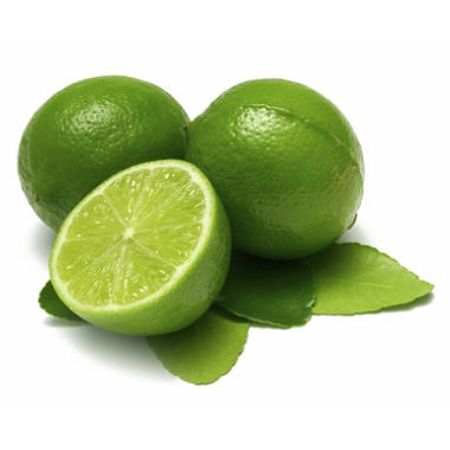




Botanical name Citrus aurantifolia
Family Rutaceae
Source Fruit Peel
Origin Peru
Processing Method Cold Pressed
Color/Consistency A thin, clear, yellowish green to greenish brown liquid.
Aromatic Summary / Note / Strength of Aroma A top note with a medium aroma, it has a tart, fresh scent characteristic of the fruit.
Blends With Clary Sage, Lavender, Neroli and Ylang-Ylang.
Product Abstract
Lime Essential Oil is amongst the most affordable of essential oils and is routinely used for its energizing, fresh and cheerful aroma. It is well known in folklore for its ability to cleanse, purify and renew the spirit and the mind. It is also said to be effective in cleansing the aura. Lime essential oil is rich in Vitamin C, making the oil an ideal immune system booster. Lime can be used in a diffusor or vaporizer to assist with relief from stress, anxiety, and allow for a calm mind.
History
Although the precise origin is uncertain, wild limes are believed to have first grown in Indonesia or Southeast Asia, and then were transported to the Mediterranean region and north Africa around 1000 CE.
To prevent scurvy during the 19th century, British sailors were issued a daily allowance of citrus, such as lemon, and later switched to lime. The use of citrus was initially a closely guarded military secret, as scurvy was a common scourge of various national navies, and the ability to remain at sea for lengthy periods without contracting the disorder was a huge benefit for the military. The British sailor thus acquired the nickname, "Limey" because of their usage of limes.
Harvesting/Extraction Information
The essential oil of lime is extracted by cold compression of fresh lime peels or by steam distillation of its dried peels. The scientific name of lime is Citrus aurantifolia. It is composed of compounds like alpha pinene, beta pinene, myrcene, limonene, terpinolene, cineole, linalool, borneol, citral, neral acetate, and geranyl acetate.
Common Usage
Caution
In very rare cases, this oil can cause photosensitivity if exposed directly to the strong sun after application.
Key constituents
(β)-Limonene 51.5–59.6%
β-Pinene 12.2–16.0%
g-Terpinene 1.3–14.4%
p-Cymene 0.4–10.4%
α-Pinene 2.0–5.0%
Geranial 2.2–3.9%
Sabinene 0.9–2.1%
β-Myrcene 0.9–1.8%
β-Bisabolene 0.2–1.7%
Neryl acetate 0.4–1.5%
β-Bergamotene 1.0–1.4%
Neral 0.5–1.2%
Non-volatile compounds
7-Methoxy-5-geranoxycoumarin 1.7–5.2%
5-Geranoxy-7-methoxycoumarin 1.7–3.2%
Bergamottin 1.7–3.0%
Citropten 0.4–2.2%
Isopimpinellin 0.1–1.3%
5-Geranoxy-8-methoxypsoralen 0.2–0.9%
Bergapten 0.17–0.33%
Oxypeucedanin 0.02–0.3%
8-Geranoxypsoralen 0.10–0.14%
Safety summary
Hazards Skin sensitization if oxidized; phototoxic; may be photocarcinogenic.
Contraindications (dermal) If applied to the skin at over maximum use level, skin must not be exposed to sunlight or sunbed rays for 12 hours.
Cautions Old or oxidized oils should be avoided.
Maximum dermal use level 0.7%
Our safety advice
Because of its (β)-limonene content we recommend that oxidation of expressed lime oil is avoided by storage in a dark, airtight container in a refrigerator. The addition of an antioxidant to preparations containing it is recommended.
Regulatory guidelines
Has GRAS status. In Europe, essential oils containing furanocoumarins must be used so that the total level of bergapten will
Not exceed (α) 15 ppm in finished cosmetic products intended for application to skin areas likely to be exposed to sunshine, excluding rinse-off products; or (β) 1 ppm in sun protection and in bronzing products. In the presence of other phototoxic ingredients, the sum of their concentrations shall not exceed 100%. In order to avoid phototoxicity, IFRA recommends that, for application to areas of skin exposed to sunshine, expressed lime oil be limited to a maximum of 0.7% in products applied to the skin except for bath preparations, soaps and other wash-off products. IFRA also recommends that essential oils rich in limonene should only be used when the level of peroxides is kept to the lowest practical level, for instance by adding antioxidants at the time of production.
Organ-specific effects
Adverse skin reactions No irritation or sensitization data could be found. Expressed lime oil was phototoxic when applied to human skin. Phototoxicity is due to bergapten and other furanocoumarins. Bergapten is photocarcinogenic. Eleven cases of photodermatitis from expressed lime oil have been reported, and photodynamic reaction was experimentally produced by expressed lime oil on the skin and subsequent solar irradiation. Autoxidation products of (β)-limonene can cause skin sensitization.
Reproductive toxicity The low reproductive toxicity of (β)- limonene and β-pinene suggests that expressed lime oil is not hazardous in pregnancy.
Systemic effects
Acute toxicity No information found.!
Antioxidant/pro-oxidant activity Persian lime oil has demonstrated marked DPPH radical scavenging activity. Lime terpenes induced glutathione S-transferase activity to more than 2.5 times control level in mouse tissues.
Carcinogenic/anticarcinogenic potential Lime oil (type unspecified) has been reported as a promotor of tumors in the forestomach and in the skin of rats pre-treated with DMBA; most of these papillomas were benign, but a few were malignant. Lime oil was not mutagenic in the Ames test, and did not produce CA in Chinese hamster fibroblasts. Citral and (β)-limonene display anticarcinogenic activity.
Comments
Lime oil is not regarded as a carcinogen by any agency. The nonvolatile residue of cold-pressed lime oil is thought to be higher than for any other citrus oil, and has been reported as 6.7–15.4%. The terms ‘Mexican’, ‘Persian’, etc. are employed to describe the type of lime, and do not necessarily denote country of origin.